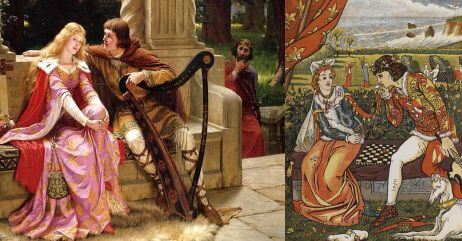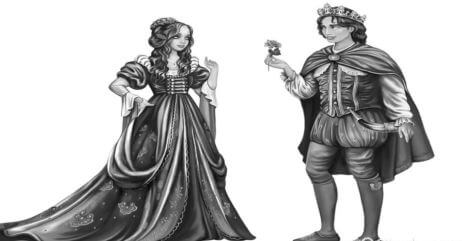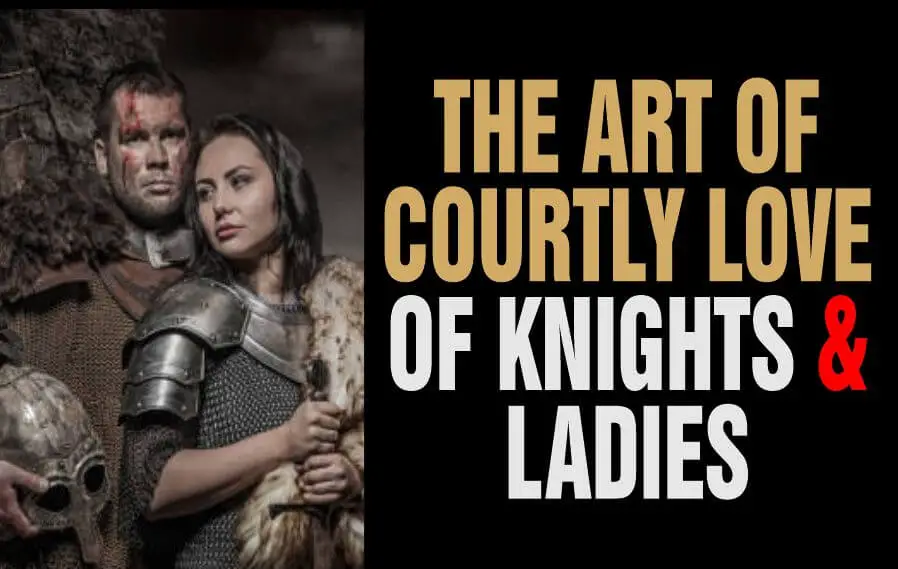Last updated on August 18th, 2023 at 02:29 pm
The medieval period was a time not only marked by chivalry and warfare but also by a knightly romance with noblewomen called courtly love.
This art of love, practiced by knights and ladies, played a significant role in shaping the social and cultural fabric of medieval society.
Love in the court elevated the status of women, emphasizing their beauty, grace, and intellectual qualities.
It was a refined and delicate approach to romance, characterized by illicit desires kept secret and noble ideals of devotion and honor.
This risky and clandestine kind of love prevailed throughout the Middle Ages and left a lasting impact on literature, art, and societal norms.
You might want to check out the rules of courtly romance here.
Table of Contents
- Courtly Love Definition and Historical Context
- What is Meant by the Tradition of Courtly Love?
- Origin and Evolution of Courtly Love
- The Art of Courtly Love and Characteristics
- Medieval Literature and Courtly Love
- Courtly Love of Art and Music
- Impact of Courtly Romance on Society
- Legacy of Courtly Romance in Modern Culture
- Conclusion
- Frequently Asked Questions
Courtly Love Definition and Historical Context

Courtly affair is a medieval European concept that originated in the 12th century and flourished until the Renaissance.
It is a romanticized form of love that was practiced within the aristocratic courts of the time.
This concept idealized the lover, who was often a knight, as a poet, musician, and chivalrous figure.
Courtly romance emphasized the pursuit of a beloved who was usually married or of a higher social status.
It involved elaborate rituals, language, and gestures, and was focused on the admiration, devotion, and often unrequited love of the noblewoman.
Related: Acts of Chivalry for Modern Society
What is Meant by the Tradition of Courtly Love?
The tradition of romance in the court is a medieval European concept of romantic love between knights and noblewomen.
The tradition placed the lady at the center of worship, with the knight as her loyal and devoted servant.
The concept involved secret admiring, poetic declarations, and unrequited love for the idealized noblewoman. In this tradition, the knight would perform deeds of valor to prove the worthiness of the lady’s love.
The courtly romance was marked by a highly formalized code of conduct, refining the knight’s behaviour and idealizing the relationship between men and women.
Origin and Evolution of Courtly Love

The concept of courtly romance emerged during the medieval period in Western Europe, particularly in France, around the 12th century.
It was a highly idealized and stylized form of love that was associated with the nobility and the courts.
It was considered a noble and refined way of expressing romantic feelings, often involving a secret and platonic relationship between a knight and a noblewoman.
Let’s take a closer look…
Influences from Troubadours and Chivalry
Troubadours were poet-musicians who originated in southern France. They composed songs and poems that idealized love and celebrated the virtues of their noble patrons.
Troubadours played a significant role in shaping the concept of romance by popularizing the idea of romantic love and introducing the notion of a lover’s dedication to a lady whom he admired from afar.
Also, troubadours often performed in the courts of nobles, which helped spread the concept of courtly romance among the upper classes.
Chivalry, on the other hand, was a knightly code of conduct that emphasized virtues such as honour, loyalty, bravery, and courtesy.
Courtly romantic affairs drew inspiration from the ideals of chivalry, as it encouraged knights to exhibit these virtues in their pursuit of romantic love.
The romanticized image of the knight as a noble protector and servant of his lady played a central role in courtly romance evolution.
Related: Lessons from the Code of Chivalry
Connection to the Concept of Knighthood and the Code of Chivalry
Courtly romantic affairs and knighthood shared a close connection as both concepts were intertwined during the medieval period.
Knights, who were often members of the nobility, were expected to adhere to the code of chivalry, which included not only martial skills but also the ability to express devotion and courtesy towards noblewomen.
This medieval romance became a means for knights to demonstrate their chivalrous qualities by displaying their dedication, loyalty, and self-sacrifice towards their chosen lady.
The code of chivalry emphasized the importance of honour, respect, and proper conduct within the framework of courtly relationships.
Knights were expected to serve their ladies with utmost devotion and to protect their reputations.
The idea of servitude and devotion to the lady served as a parallel to the knight’s obligations towards his lord in the feudal system.
Impact of the Courts and Noble Courts on the Development of Courtly Love
The courts, particularly noble courts, influenced the development and spread of courtly romance.
The courts were centers of power and culture, where the nobility would gather and engage in various activities, including debates, music, poetry, and courtly rituals.
The courtly romance was often performed and celebrated in the courts, giving it social and cultural significance.
Noble courts provided a platform for courtly relationships to flourish, as knights would court noblewomen and engage in acts of chivalry to gain their favor and admiration.
The courts also served as a hub for troubadours, who would entertain the nobles with their songs and poems about love.
The patronage of the nobility towards arts and literature further fueled the popularity and development of courtly romantic affairs.
Related: Why Chivalry Might not be Dead Afterall
The Art of Courtly Love and Characteristics
There are several characteristic themes and aspects associated with love in the courts, most of which hinged on the knight’s devotion, adultery, secrecy, love letters, poetry, songs, unrequited love, and suffering.
Let’s take a closer look at these:
Idealization of the Lady and the Knight’s Devotion: Love in the courts portrays the lady as revered and unattainable, often married or of higher status. The devoted knight aims to win her favour through chivalry, humility, and loyalty. His unwavering devotion makes her his focal point, guiding his actions and honoring her as the center of his world.
The Concept of Adultery and Secrecy in Courtly Romance: Courtly romance thrives on forbidden love, often involving a married lady. Adultery is a recurring theme, concealed discreetly to evade scandal. The secrecy adds excitement and peril, intensifying the allure of the affair within the courtly context.
The Role of Love Letters, Poetry, and Songs in Courtly Love: Knightly love employs intricate artistic communication, featuring love letters, poems, songs, and writings as primary means of expression. These convey profound emotions, admiration, and longing for the lady, epitomizing romance’s ideals. Such compositions showcase language’s potency in articulating intense emotions and desires within courtly relationships.
Unrequited Love and Suffering: Unrequited love is pivotal in knightly love. The lady’s non-reciprocation, driven by societal norms or marital commitment, creates longing and despair. This unattainability infuses the knight’s emotions with suffering, portraying him as love’s slave, enduring torment for affection’s sake.
Related: Unravelling Online Chivalry
Medieval Literature and Courtly Love

Medieval literature refers to the literary works produced during the Middle Ages, a period that stretches from the 5th to the 15th century.
This era was marked by significant cultural, political, and social changes, and literature played a vital role in reflecting and shaping these developments.
Love in the courts, or amour courtois in Old French, was a cultural and literary phenomenon that emerged in the medieval courts of Europe.
It depicted a chivalric ideal of love, often involving a knight and his lady fair, based on admiration, purity, and devotion.
The Influence of Courtly Love on Literature
Medieval romance of the knights and noblewomen profoundly shaped medieval literature, especially troubadour poetry, romance novels, and Arthurian legends. Originating in Southern France, troubadour poets praised noble patrons, often married, through verses of unrequited love and devotion.
Romance novels emerged in the 12th century, revolving around chivalry and quests for noblewoman’s favour. Arthurian legends, like Lancelot’s love for Guinevere, illustrated the tension between knights’ and ladies’ romance ideals and chivalric codes.
Notable Authors on Courtly Affairs
Marie de France, a medieval poet, significantly shaped courtly romantic affair literature. Her 12th-century works like “Lais” and “The Fables” explore love, desire, and human emotions, challenging gender roles.
Chrétien de Troyes, another influencer, crafted Arthurian romances exemplifying romantic themes of honor, loyalty, and devotion. Andreas Capellanus authored “The Art of Courtly Love,” analyzing love principles and etiquette, guiding nobles in navigating these dynamics. While not narrative, Capellanus’s treatise influenced literary portrayals of courtly romance, aiding the genre’s development.
Characters and their Portrayals of Courtly Romance
In Arthurian legends, Lancelot and Guinevere exemplify this clandestine romance. Lancelot loves King Arthur’s wife, creating conflict in the court. His devotion and struggle mirror the courtly romance dichotomy. Tristan and Isolde, in another instance, love despite her marriage.
Their intense yet doomed love highlights longing and societal boundaries. “Sir Gawain and Lady Ragnell” defies norms. Gawain marries a cursed hag, revealing her beauty through kindness. The tale subverts courtly romantic affairs, focusing on inner beauty and genuine connections over appearances.
Related: Examples of Medieval Courtly Love
Courtly Love of Art and Music
Love in the courts of art and music was characterized by a ritualized and idealized form of love that was primarily associated with the courtly lifestyle and chivalry.
More explanations are below…
Depictions of Courtly Love in Paintings, Tapestries, and Sculptures
Visual arts portrayed courtly romance through paintings, tapestries, and sculptures. These depicted courtly romance and its phases, featuring knights expressing devotion to virtuous ladies.
Ladies, often embodiments of beauty, could be objects of desire, occasionally evoking unattainability or courtship by multiple suitors.
These artworks aimed to convey knights’ and ladies’ romance ideals, highlighting devotion, chastity, and admiration from afar. Figures exuded refinement and nobility, mirroring the courtly lifestyle of the upper classes.
The Influence of Courtly Affair on Music, Including Troubadour Songs and Medieval Chants
Courtly romance significantly impacted medieval music. Notably, troubadour songs, performed by minstrels, expressed love, desire, and devotion to noble ladies in courts.
These songs emphasized emotional expression, intricate melodies, and poetic lyrics that depicted the pains of unrequited love and longing.
Medieval chants, sacred vocal pieces in religious ceremonies, also reflected the romance of the knights and ladies. Some chants connected earthly and divine love, echoing the longing and devotion of courtly romance affairs.
Examples of Courtly Love in Religious Art and the Reflection of the Dichotomy between Earthly and Divine Love
Courtly affair’s influence extended to religious art, notably in the portrayal of the Virgin Mary. Artworks depicted her as both an object of earthly and divine love, symbolizing purity and grace akin to the courtly idealized lady.
Mary’s imagery emphasized her role as a mediator between earthly and divine realms, embodying motherhood and God’s love. This reflected a connection between courtly romance and divine affection.
Impact of Courtly Romance on Society
Courtly romance has had a huge impact on society and influenced medieval and modern societies.
Here are some ways it achieved that:
The Influence of Courtly Affairs on Social Norms and Gender Roles
It centered on idealized affection between knights and often married women, elevated women’s influence and challenged gender roles.
It positioned women as desired and men as devoted, shifting norms. This concept sparked chivalry, gallantry, and manners, gradually transcending upper-class circles to impact society broadly.
Courtly Romance as a Catalyst for Cultural Change and Social Mobility
It enabled cultural shifts and social mobility in a hierarchical medieval society. Adherence to love’s ideals, like loyalty and bravery, could elevate individuals regardless of their birth.
By excelling in love’s pursuit, one could gain recognition and influence, challenging social rigidity and contributing to the fluidity of the era.
Critiques and Controversies Surrounding Courtly Romance, Including Arguments Against its Romanticized Portrayal
This romance between knights and ladies faced critics who contended it masked adultery, involving knights and married women. Idealized portrayals were deemed unrealistic, enhancing unattainable relationship standards.
Accused of manipulation and harm, the clandestine love was criticized for prioritizing nobility’s desires, neglecting the lower classes. Critics questioned its narrow view and condemned its potential to inflict suffering in a deceptive game.
Legacy of Courtly Romance in Modern Culture
The legacy of courtly love in modern culture is evident in various aspects of contemporary society, including parallels and comparisons between courtly romance and contemporary romantic relationships.
Also, its influence on modern literature, music, and art, and the enduring fascination with courtly romance in popular culture are notable.
Parallels and Comparisons Between Courtly Love and Contemporary Romantic Relationships
In contemporary romantic relationships, we can observe parallels with courtly relationships. For instance, unrequited love or longing for someone who is unattainable is a theme that still resonates in modern society.
Additionally, the notion of idealized love, where individuals see their partners as perfect and place them on a pedestal, can be traced back to courtly romance.
Influence of Courtly Romance on Modern Literature, Music, and Art
Modern art forms reflect courtly love’s impact. Literature reimagines its themes, as seen in “The Great Gatsby” and “Wuthering Heights.” Music draws inspiration, with romantic ballads echoing unattainable love, evident in “Someone Like You” and “Can’t Help Falling in Love.”
Art, as well, portrays idealized romance, akin to courtly relationships, exemplified in “The Birth of Venus” and “The Kiss,” showcasing passionate yet non-sexual affection between couples.
The Enduring Fascination with Courtly Love in Popular Culture
The courtly romance continues to captivate popular culture, evident in movies, TV shows, and novels. The romanticized notion of forbidden love or desire for someone unattainable is a recurring theme in these mediums.
Movies like “The Notebook” or “Romeo and Juliet” embody the ideals of courtly romance, featuring passionate yet problematic relationships. TV shows like “Downton Abbey” or “Outlander” also draw on courtly love elements, showcasing love between characters from different social classes or time periods.
In the realm of novels, stories like “Twilight” or the “Fifty Shades of Grey” series reflect courtly romance elements, with protagonists yearning for their unattainable love interests. These stories often emphasize the idolization of the beloved and the difficulty of fulfilling romantic desires.
Conclusion
The art of courtly love and its depiction of the relationship between knights and ladies continues to captivate audiences to this day.
Its enduring appeal lies in its exploration of themes such as chivalry, desire, and the intricacies of human emotions.
Moreover, it provides valuable insights into the social dynamics of medieval society, reflecting the ideals and expectations of the time.
It serves as a lens through which we can understand the complexities of love, power, and gender roles in a historical context.
By studying this risky love affair, we gain a deeper appreciation for the evolution of romantic relationships and the timeless yearning for connection and affection.
Frequently Asked Questions
What is chivalry and courtly love?
Chivalry is a medieval code of conduct for knights, emphasizing virtues like courage, loyalty, and honour. It is a romantic concept that idealizes noble love, often involving a knight’s devotion to an unattainable lady.
Is courtly love part of chivalry?
Yes, it is often associated with chivalry. Knights expressed courtly love’s ideals through chivalrous acts, intertwining their devotion to both love and honor.
What is an example of courtly Romance?
An example of this is Lancelot’s affection for Queen Guinevere in Arthurian legends. Despite her marriage to King Arthur, Lancelot’s devoted admiration illustrates courtly romance complexities.
What is the meaning of courtly chivalry?
Courtly chivalry is the amalgamation of chivalric virtues with the principles of courtly love. It signifies knights demonstrating honour, loyalty, and noble conduct on the battlefield, and devotion, admiration, and respect in their romantic interactions.
References:
Pyo Merez, a social psychologist and avid writer, specializes in unraveling the intricate relationship between gentlemen and society.
With years of experience studying human behaviour, he offers unique insights into how societal norms shape gentlemen’s identity and vice versa.
Through his captivating and thought-provoking articles, Pyo taps into the depths of gentlemanliness and masculinity and provides valuable perspectives on etiquette and manners in modern society.
Prepare to embark on an enlightening journey with Pyo Chims as he dives deep into the world of gentlemen’s culture and society.

